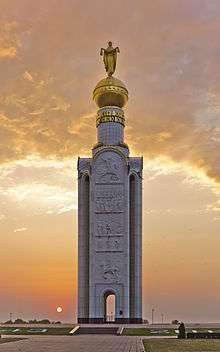Prokhorovka, Belgorod Oblast
Coordinates: 51°02′11″N 36°44′11″E / 51.03639°N 36.73639°E


Prokhorovka (Russian: Про́хоровка) is an urban locality (a settlement) and the administrative center of Prokhorovsky District of Belgorod Oblast, Russia, located along the Psyol River southeast of the city of Kursk. Population: 9,761 (2010 Census);[1] 10,007 (2002 Census);[2] 8,093 (1989 Census).[3]
History
The first mention of the populated area in historical documents dates back to the second half of the 17th century. Polish nobleman Kiril G. Ilyinsky of the genus Korczak (Korczak) and his son Sava left during the Russian-Polish war of 1654-1667 in Poland under the Belgorod, where they founded the suburb Elias. In 1860 Elias Sloboda was renamed in honor of the reigning Emperor Alexander II in the village of Alexandrov.
In the 1880s west of the village passed a line of the Kursk-Kharkov-Azov railway. At the same time Prokhorovka station was built, named after the railway engineer names VI Prokhorov responsible for its construction.
In the summer of 1943, Prokhorovka was the site of the Battle of Prokhorovka, a major armored confrontation during the Battle of Kursk of World War II. In July 2013, Vice Prime Minister Dmitry Rogozin offered to establish by 2015 a museum commemorating the battle. The display of armored vehicles will be permanent and the technologies shown there will bring up recollections of the events of World War II.[4]
In the postwar years, the village has outgrown Aleksandrovskoe and included the station Prokhorovka, which was the western part of the village. On June 20, 1968 the village Alexandrov was transferred to the category of workers' settlement (Alexandrovsky village). On September 20 the same year, Alexandrovo was abolished, and the locality was incorporated Prokhorovka.
Transportation
Prokhorovka serves as a railway station on a major railway linking Moscow and the Ukrainian city of Kharkiv.
References
| Wikivoyage has a travel guide for Prokhorovka. |
- ↑ Russian Federal State Statistics Service (2011). "Всероссийская перепись населения 2010 года. Том 1" [2010 All-Russian Population Census, vol. 1]. Всероссийская перепись населения 2010 года (2010 All-Russia Population Census) (in Russian). Federal State Statistics Service. Retrieved June 29, 2012.
- ↑ Russian Federal State Statistics Service (May 21, 2004). "Численность населения России, субъектов Российской Федерации в составе федеральных округов, районов, городских поселений, сельских населённых пунктов – районных центров и сельских населённых пунктов с населением 3 тысячи и более человек" [Population of Russia, Its Federal Districts, Federal Subjects, Districts, Urban Localities, Rural Localities—Administrative Centers, and Rural Localities with Population of Over 3,000] (XLS). Всероссийская перепись населения 2002 года [All-Russia Population Census of 2002] (in Russian). Retrieved August 9, 2014.
- ↑ Demoscope Weekly (1989). "Всесоюзная перепись населения 1989 г. Численность наличного населения союзных и автономных республик, автономных областей и округов, краёв, областей, районов, городских поселений и сёл-райцентров" [All Union Population Census of 1989: Present Population of Union and Autonomous Republics, Autonomous Oblasts and Okrugs, Krais, Oblasts, Districts, Urban Settlements, and Villages Serving as District Administrative Centers]. Всесоюзная перепись населения 1989 года [All-Union Population Census of 1989] (in Russian). Институт демографии Национального исследовательского университета: Высшая школа экономики [Institute of Demography at the National Research University: Higher School of Economics]. Retrieved August 9, 2014.
- ↑ "Deputy premier calls for creating Museum of Armor near Belgorod by 2015". Itar Tass. Retrieved July 12, 2013.